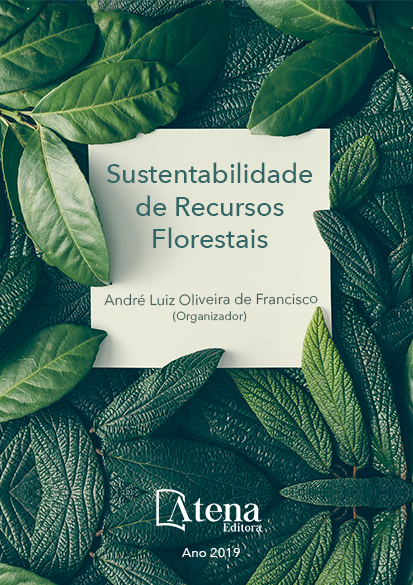
SERAPILHEIRA EM POVOAMENTO DE EUCALIPTOS: FONTE OU DRENO DE CARBONO?
A queima de combustíveis fósseis e
o desmatamento nas últimas décadas causaram
o significativo aumento de CO2 na atmosfera.
As florestas e as plantações comerciais são
importantes drenos do carbono atmosférico,
estocando o elemento na sua biomassa e
no solo. Diante desse aspecto, o presente
capítulo tem como objetivo estimar o estoque
de serapilheira acumulada e carbono em um
povoamento de Eucalyptus saligna. Para o
estudo, demarcaram-se 3 parcelas de 240 m².
Em cada uma delas coletaram-se 10 amostras
com auxílio de uma moldura com dimensões
de 25 cm x 25 cm. Em laboratório as amostras
foram separadas nas frações casca, folha, galho
e miscelânea. Em seguida foram secas em
estufa e pesadas. A estimativa do carbono deuse
por meio de índices de teores encontrados
na literatura. A fração galhos foi a classe mais
representativa (48 %), seguido pelas folhas (25
%), miscelânea (18 %) e casca (9 %). O total
de serapilheira acumulada e carbono foram de
13,1 e 5,3 Mg ha-1 respectivamente. Extensas
áreas plantadas com o gênero Eucalyptus sp.,
apresentam um grande potencial de sequestro
de carbono atmosférico por meio do acúmulo
de serapilheira e posterior incorporação parcial
do mesmo no solo.
SERAPILHEIRA EM POVOAMENTO DE EUCALIPTOS: FONTE OU DRENO DE CARBONO?
-
DOI: 10.22533/at.ed.4451916019
-
Palavras-chave: Eucalyptus saligna; sustentabilidade; silvicultura; meio ambiente
-
Keywords: Eucalyptus saligna; sustainability; forestry; environment.
-
Abstract:
The burning of fossil fuels and
deforestation in recent decades have caused a
significant increase in CO2 in the atmosphere.
Forests and commercial plantations are
important drains of atmospheric carbon, storing
the element in its biomass and soil. Considering
this aspect, the present chapter aims to estimate
the accumulated litter and carbon stock in a
Eucalyptus saligna stand. For the study, 3
parcels of 240 m² were demarcated. In each plot,
10 samples were collected using a frame with
dimensions of 25 cm x 25 cm. In the laboratory
the samples were separated into the bark, leaf,
twig and miscellaneous fractions. Then they
were oven dried and weighed. The estimation of
the carbon occurred through indexes of contents
found in the literature. The twigs fraction was
the most representative class (48%), followed
Sustentabilidade de Recursos Florestais Capítulo 9 105
by leaves (25%), miscellaneous (18%) and bark (9%). Extensive areas planted with the
genus Eucalyptus sp., reresents a great potential of atmospheric carbon sequestration
through the accumulation of litter and partial incorporation of the same in the soil.
-
Número de páginas: 15
- Dione Richer Momolli
- Mauro Valdir Schumacher
- Elias Frank Araújo


